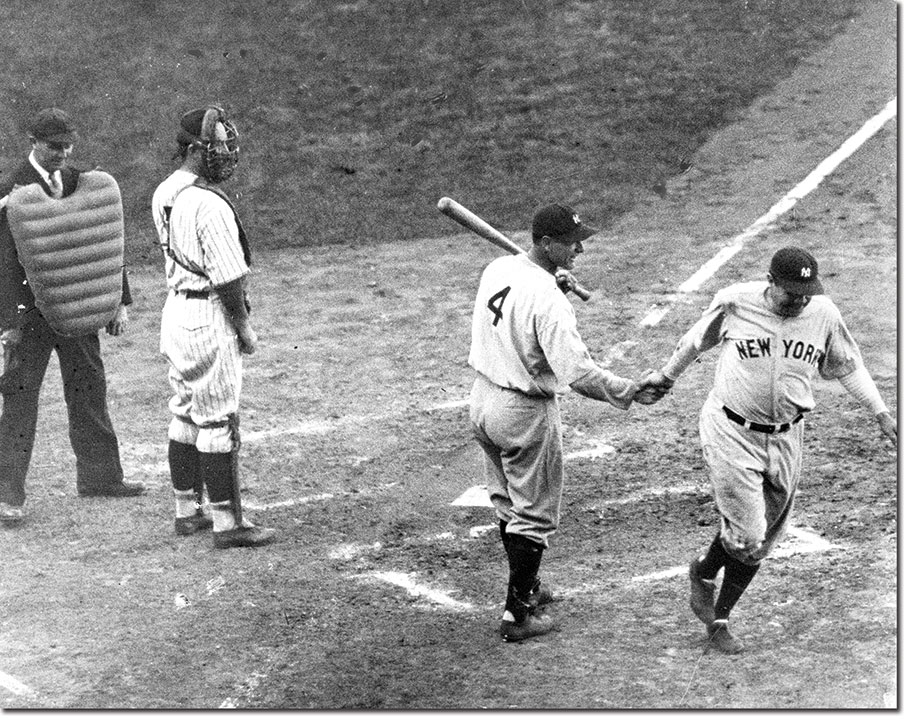Scroll Down to Read Today’s Essay
Subscribe to Baseball History Comes Alive for automatic updates. As a Free Bonus, you’ll get instant access to my Special Report: Gary’s Handy Dandy World Series Reference Guide!
Photo Gallery
Click on any image below to see photos in full size and to start Photo Gallery:
Babe Ruth’s Called Shot: “Did He or Didn’t He?”
Babe Ruth’s famous “Called Shot” came in the fifth inning of Game Three of the 1932 World Series, played on October 1, 1932, at Wrigley Field. During the at-bat, Ruth made a pointing gesture, which existing film confirms, but the exact nature of his gesture has never been settled.
The story goes that Ruth pointed to the center-field bleachers during the at-bat. It was allegedly a declaration that he would hit a home run to this part of the park. On the next pitch, Ruth hit a home run to center field. The homer was his fifteenth, and last, in his 41 post-season games.
(In the featured photo above, we see Lou Gehrig shaking Babe’s hand as Cubs’ catcher Gabby Hartnett and umpire Roy Van Grafian watch him cross the plate after his “Called Shot.”)
There is no dispute over the general events of the moment. All the reports say that the Chicago Cubs’ bench jockeys were riding Ruth mercilessly and that Ruth, rather than ignoring them, was “playing” with them through words and gestures. The longtime debate is over the nature of one of Ruth’s gestures. It is unclear if he pointed to center field, to the pitcher, Charlie Root, or to the Cubs bench. Even the films of the at-bat that emerged during the 1990s have not allowed any definitive conclusions.
With the score tied at four in the fifth inning, he took strike one from Root. As the Cubs players heckled Ruth, and the fans hurled insults, Ruth pointed with his hand. No one knows for sure what his intentions were. He then repeated this gesture after taking strike two.
Root’s next pitch was a curveball that Ruth hit at least 440 feet to the deepest part of center field near the flag pole (some estimates are as high as 490 feet). The ground distance to the center-field corner, somewhat right of straightaway center, was 440 feet. The ball landed a little bit to the right of the 440 corner and farther back, apparently in the temporary seating in Sheffield Avenue behind the permanent interior bleacher seats.
Root was left in the game, but for only one pitch, which Lou Gehrig drilled into the right-field seats for his second homer of the day. The Yankees won the game 7–5; and the next day they finished off the demoralized Cubs 13–6, completing the four-game sweep.
Here are the accounts of two who were at the game:
As the public-address announcer, Pat Pieper sat next to the wall separating the field from the stands, between home plate and third base. In 1966 he spoke with the Chicago Tribune:
I was sitting on the third base side and I remember hearing [Cubs’ pitcher] Guy Bush chide Ruth, who had taken two strikes. Ruth told Bush: ‘That’s strike two, all right. But watch this.’ Then Ruth pointed to center field and hit his homer. You bet your life Babe Ruth called it. Don’t let anybody tell you differently. Babe definitely pointed.
Associate Supreme Court Justice John Paul Stevens was at the game and has this remembrance:
My dad took me to see the World Series, and we were sitting behind third base, not too far back…. Ruth did point to the center-field scoreboard. And he did hit the ball out of the park after he pointed with his bat. So it really happened.
In 1942, during the making of The Pride of the Yankees, Babe Herman (who was at that time a teammate of Root with the minor-league Hollywood Stars) was on the movie set as a double for both Ruth (who played himself in most scenes) and Gary Cooper (who played Lou Gehrig). Herman re-introduced Root and Ruth on set and the following exchange (later recounted by Herman to baseball historian Donald Honig), took place:
Root: “You never pointed out to center field before you hit that ball off me, did you?”
Ruth: “I know I didn’t, but it made a hell of a story, didn’t it?”
Root went to his grave vehemently denying that Ruth ever pointed to center field. So did he or didn’t he? Ninety years later, the matter still isn’t settled!
Gary Livacari
Subscribe to our website, “Baseball History Comes Alive!” with over 1200 fully categorized baseball essays and photo galleries, now closing in on the one million hits mark with 870K hits and over 700 subscribers: www.baseballhistorycomesalive.com

